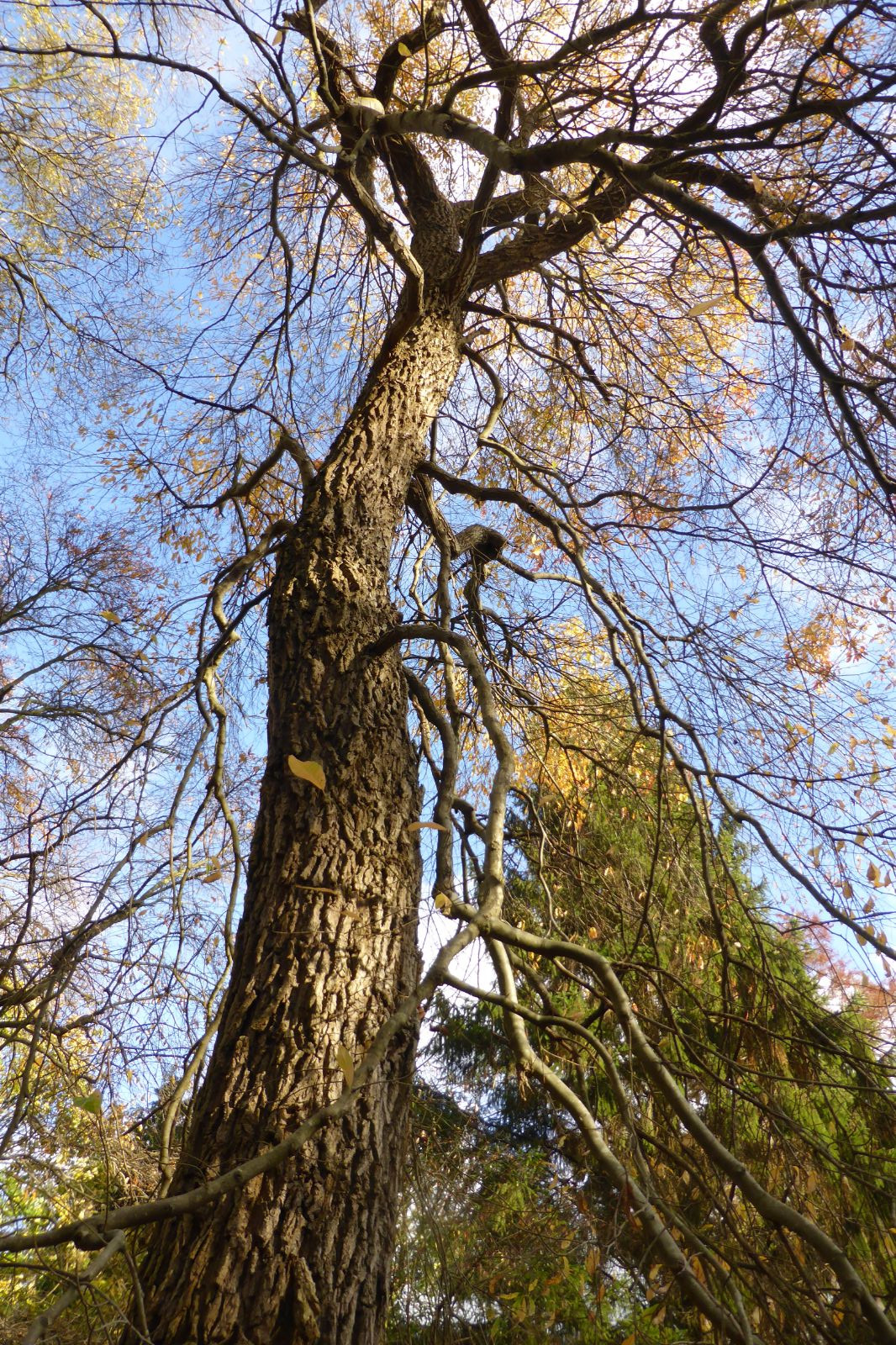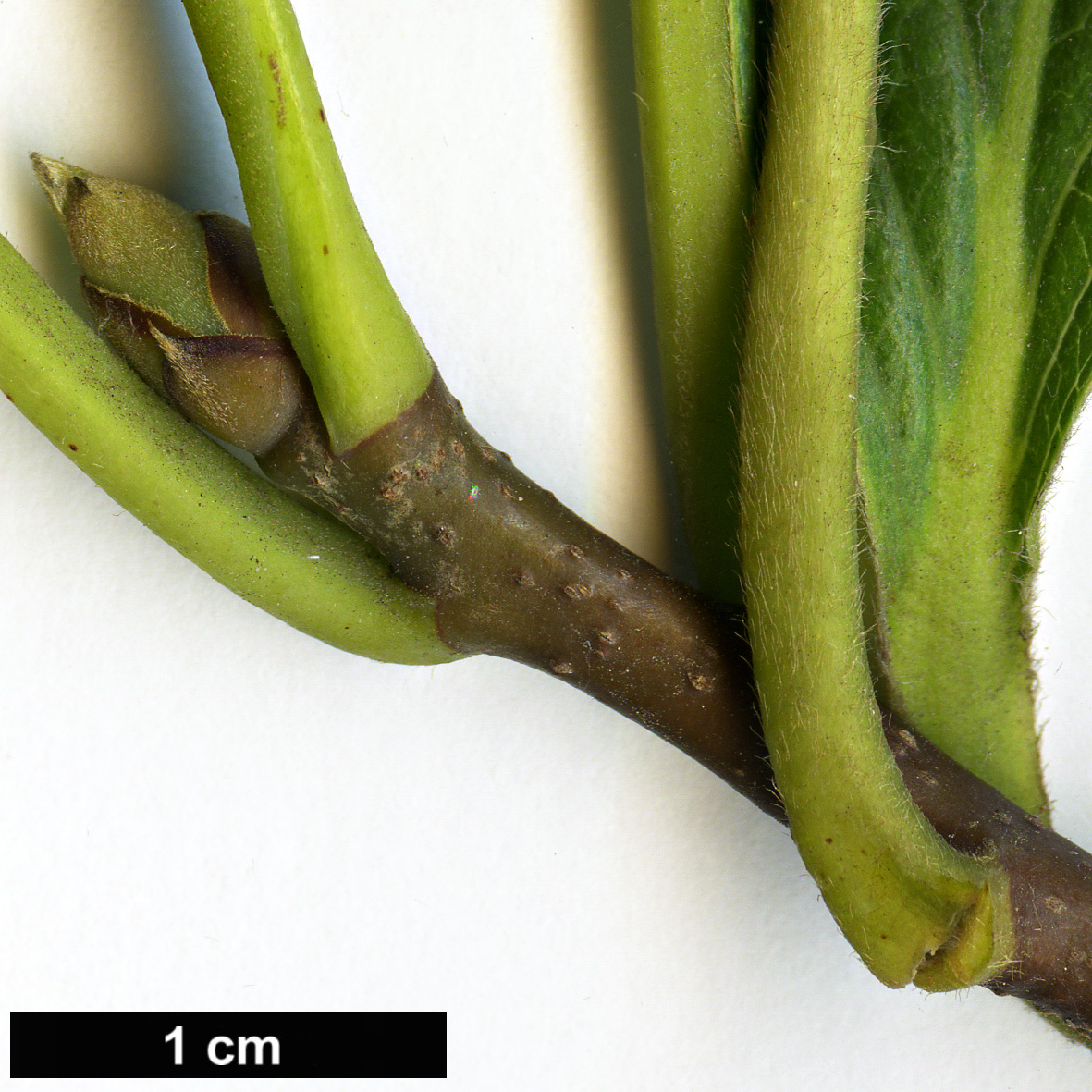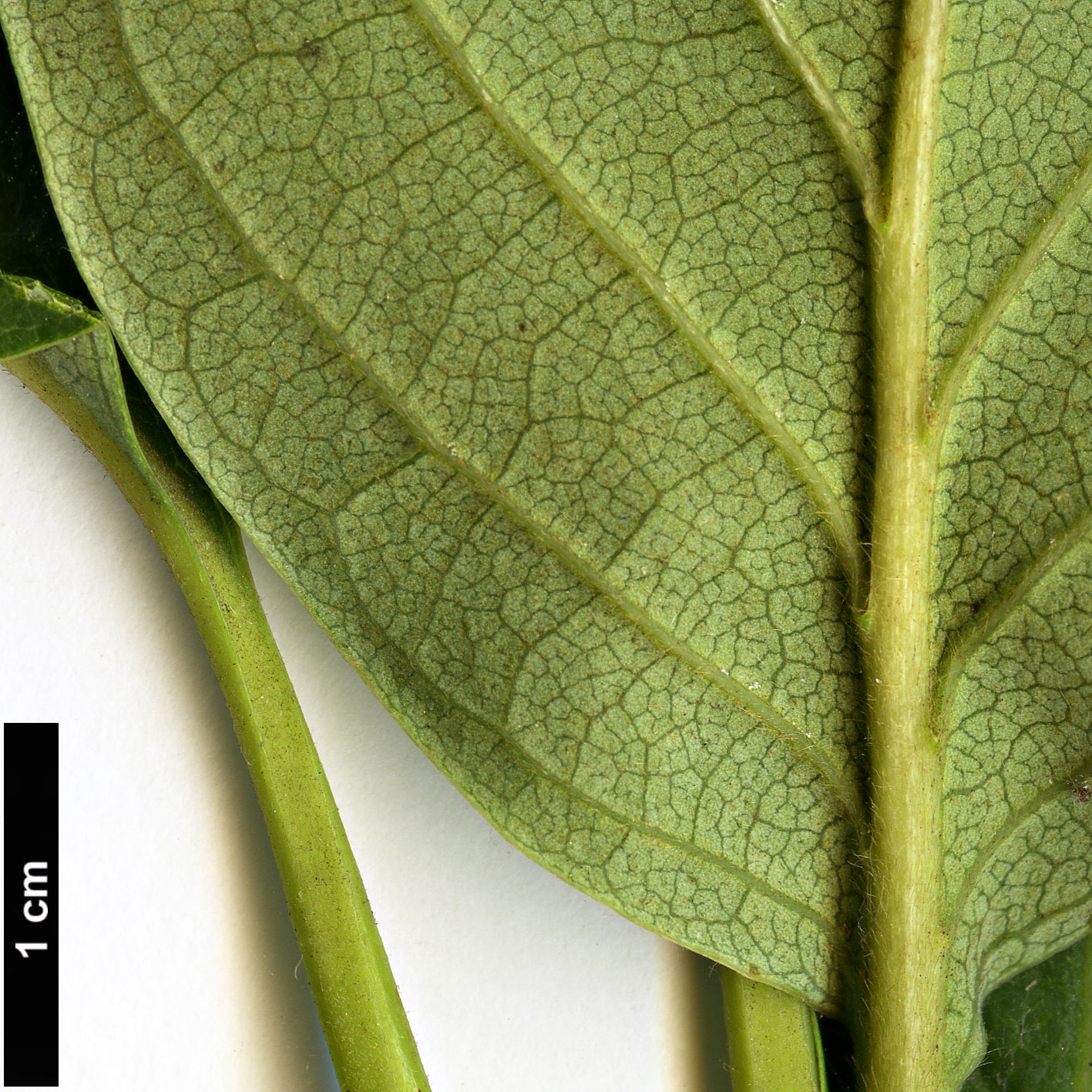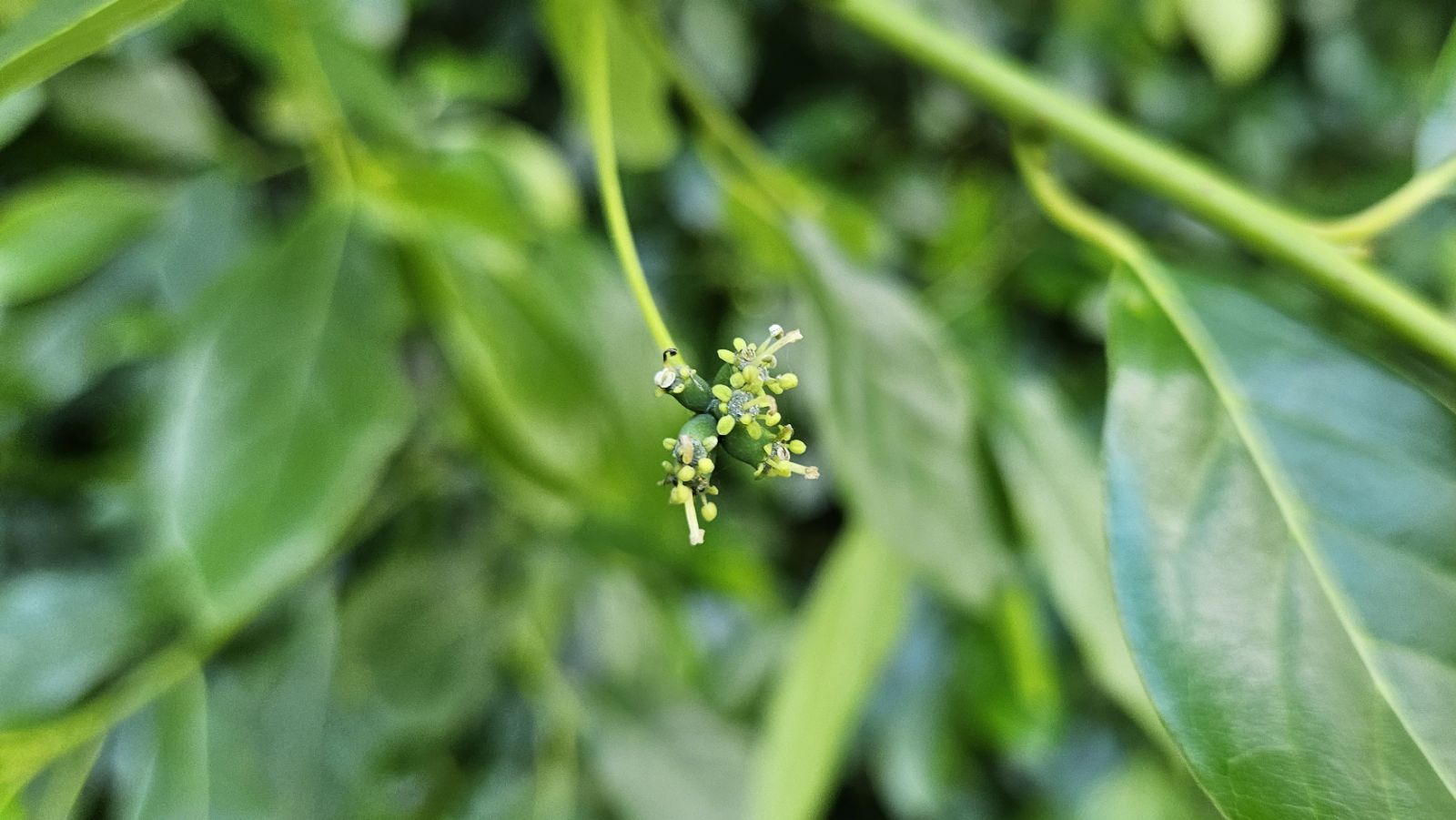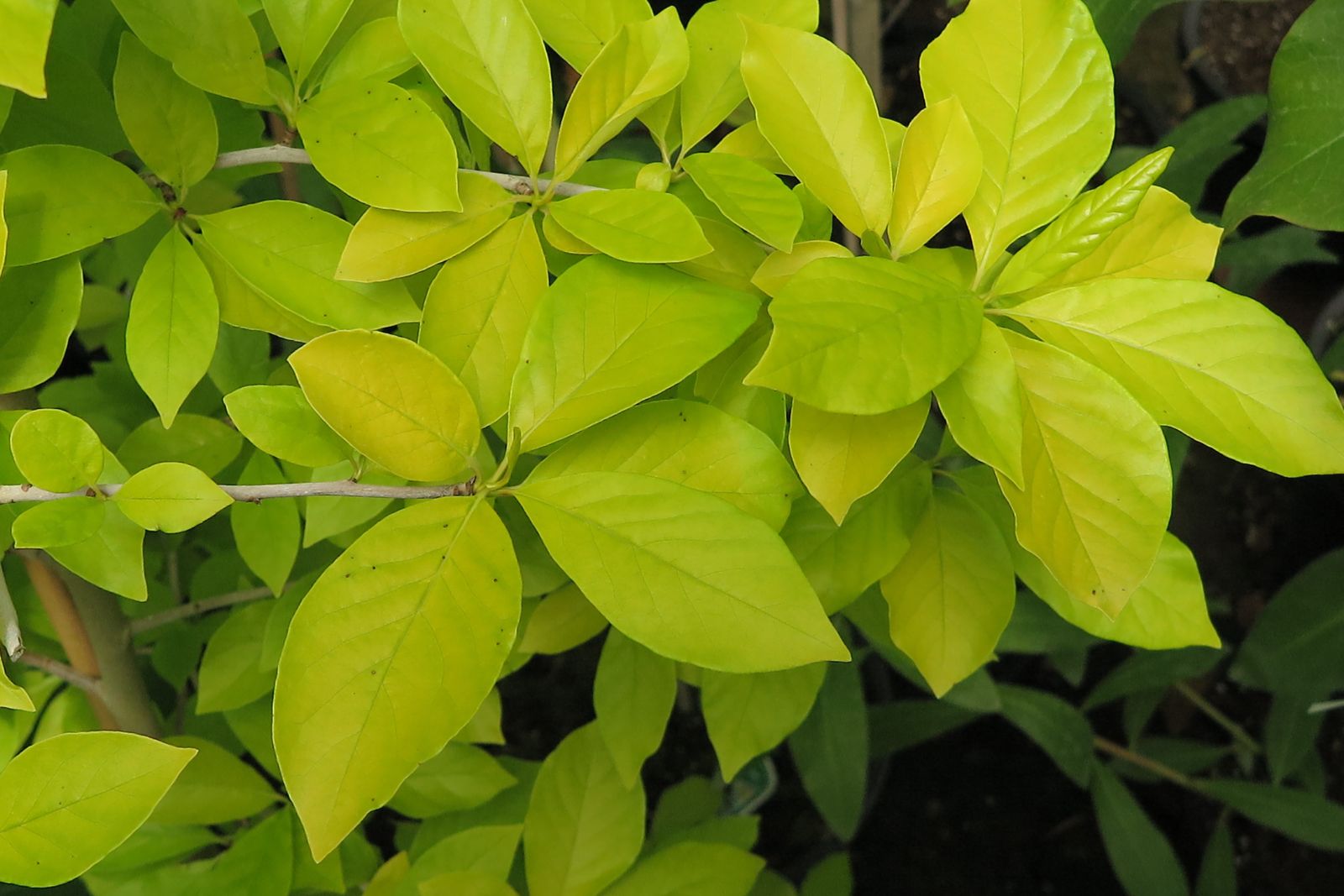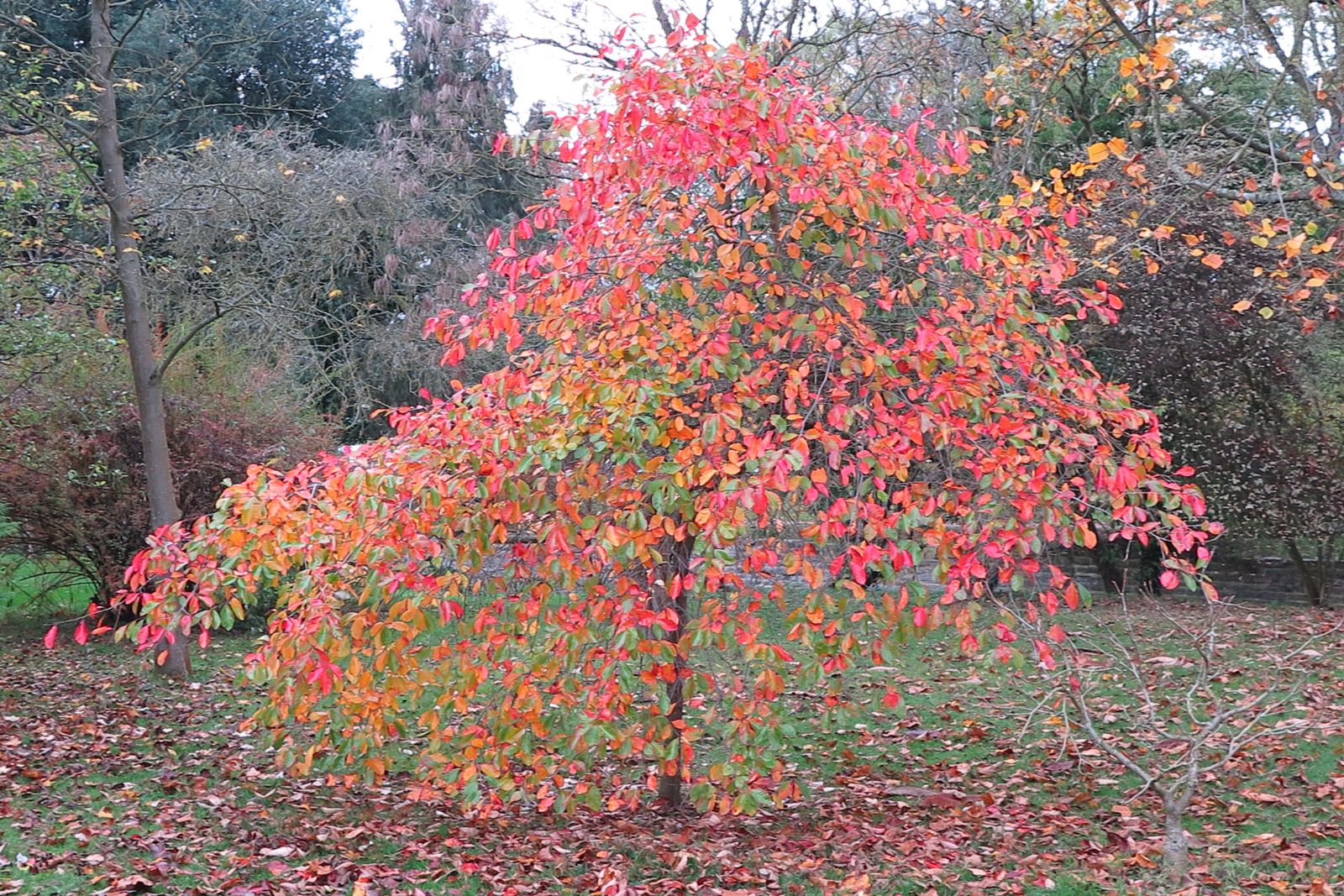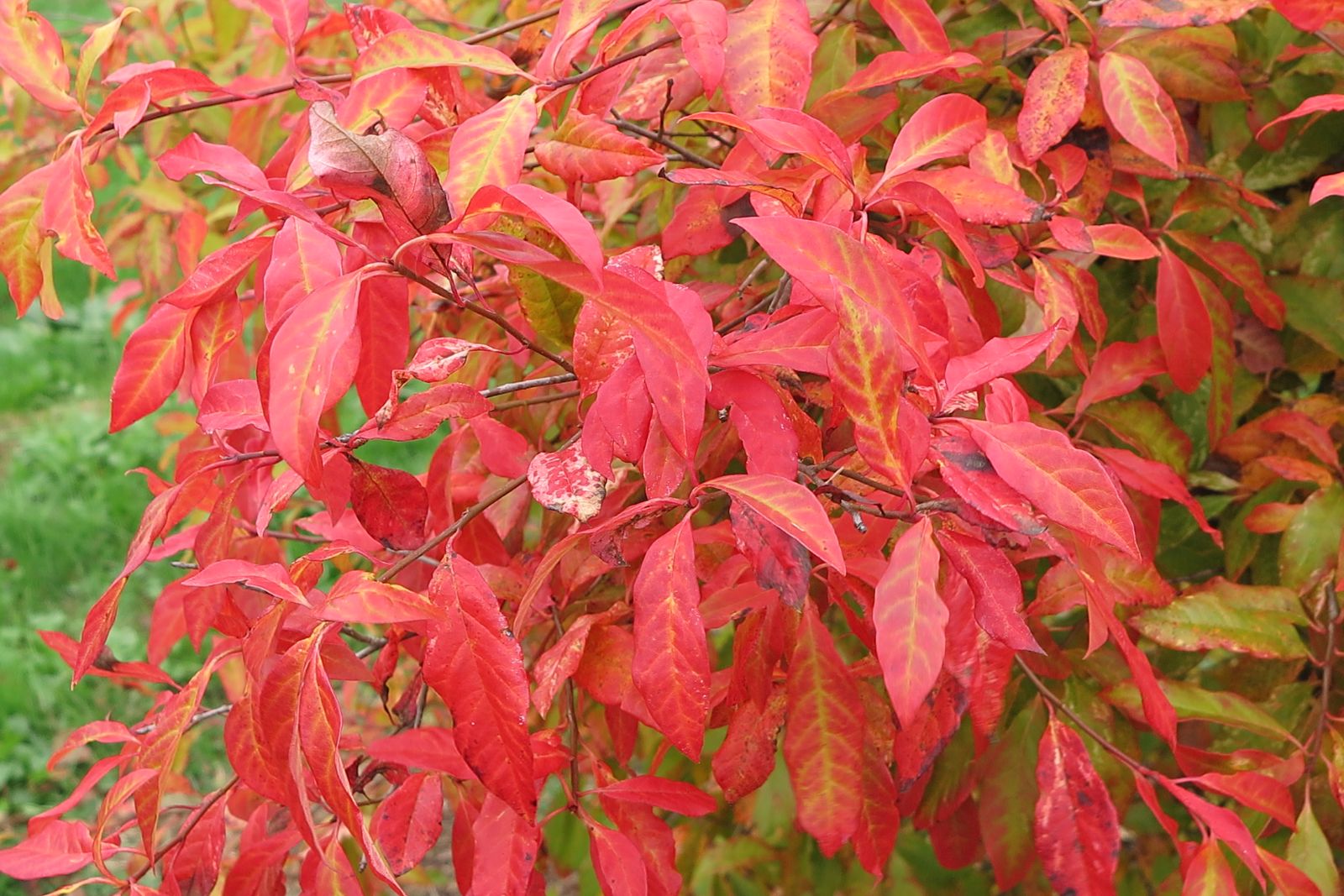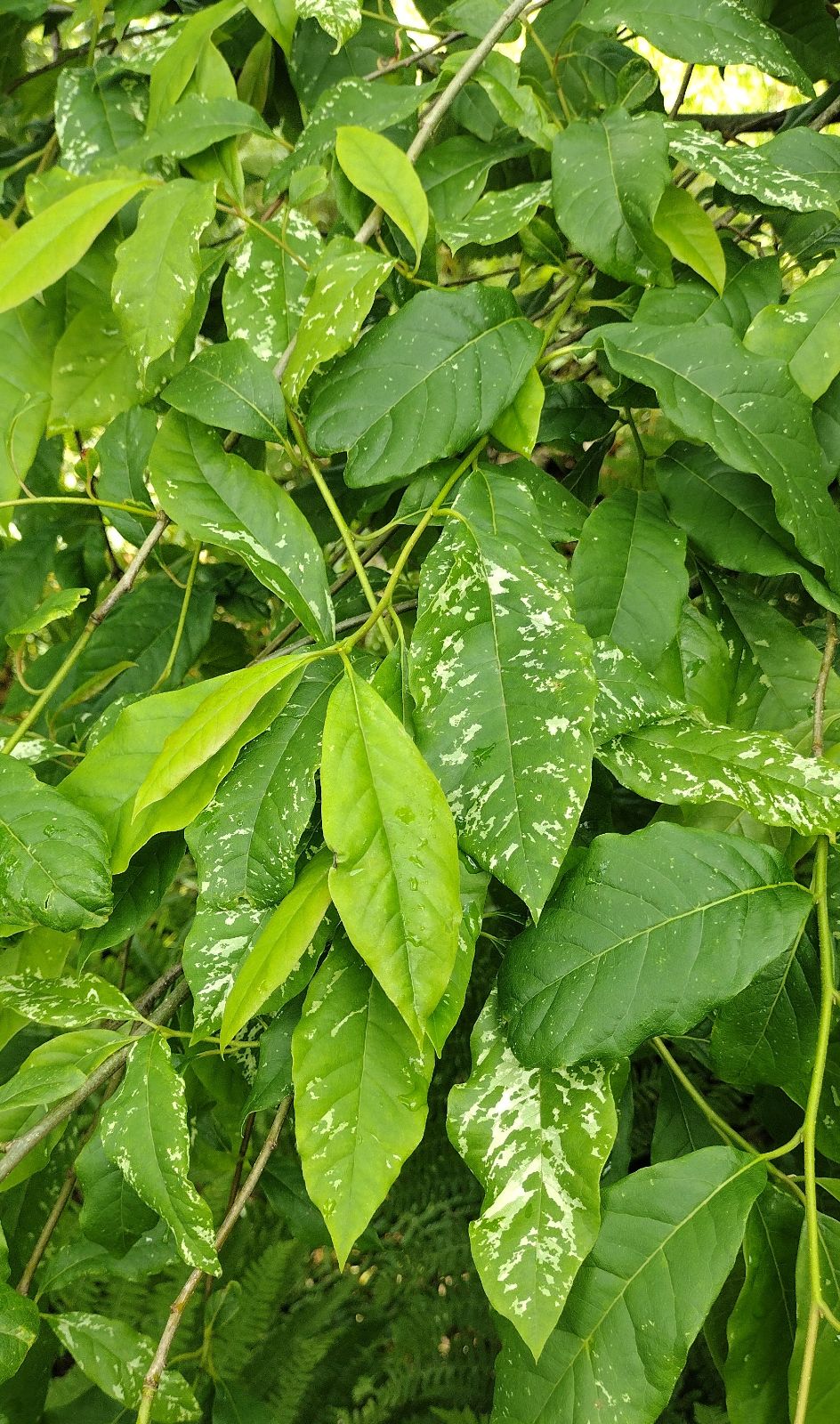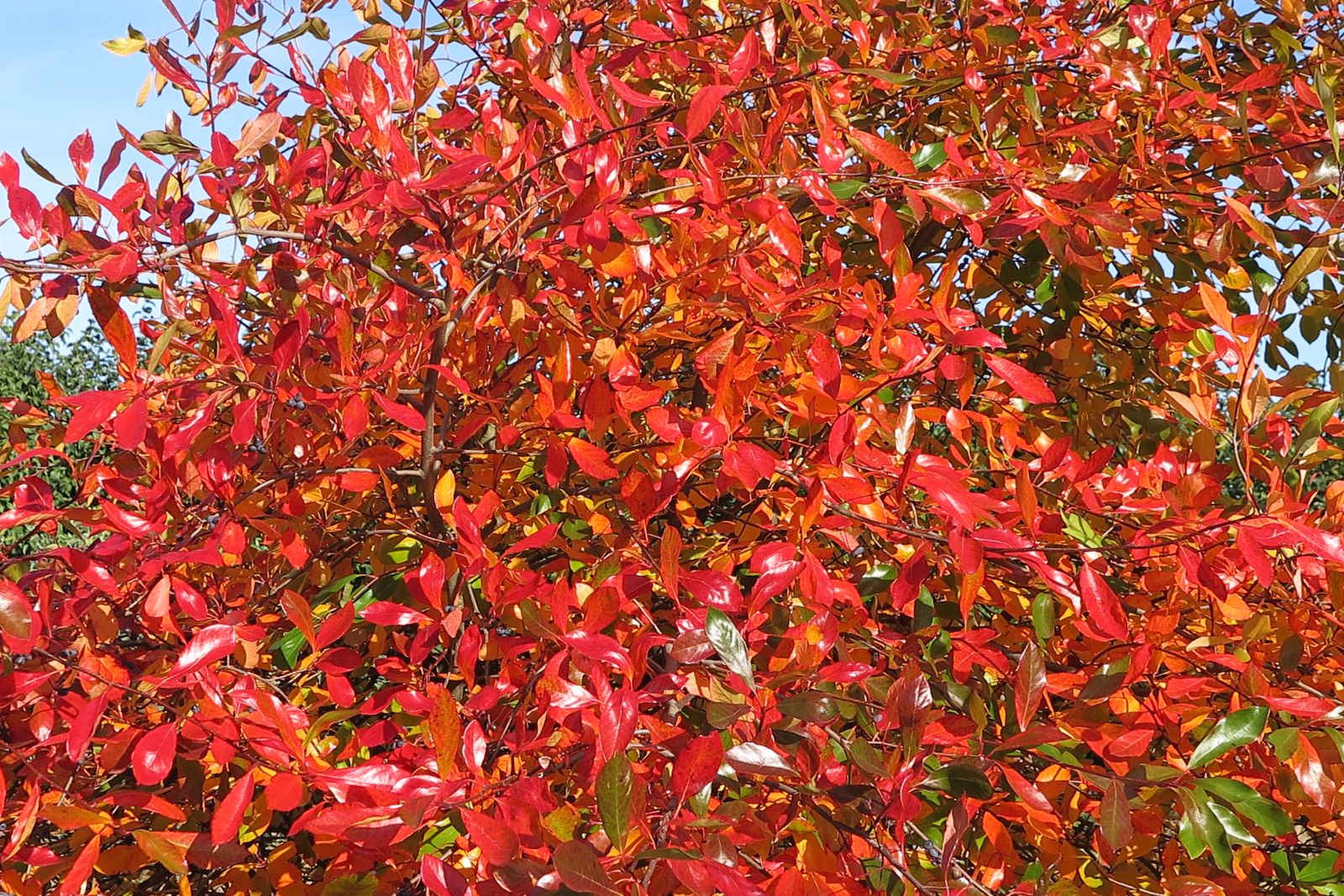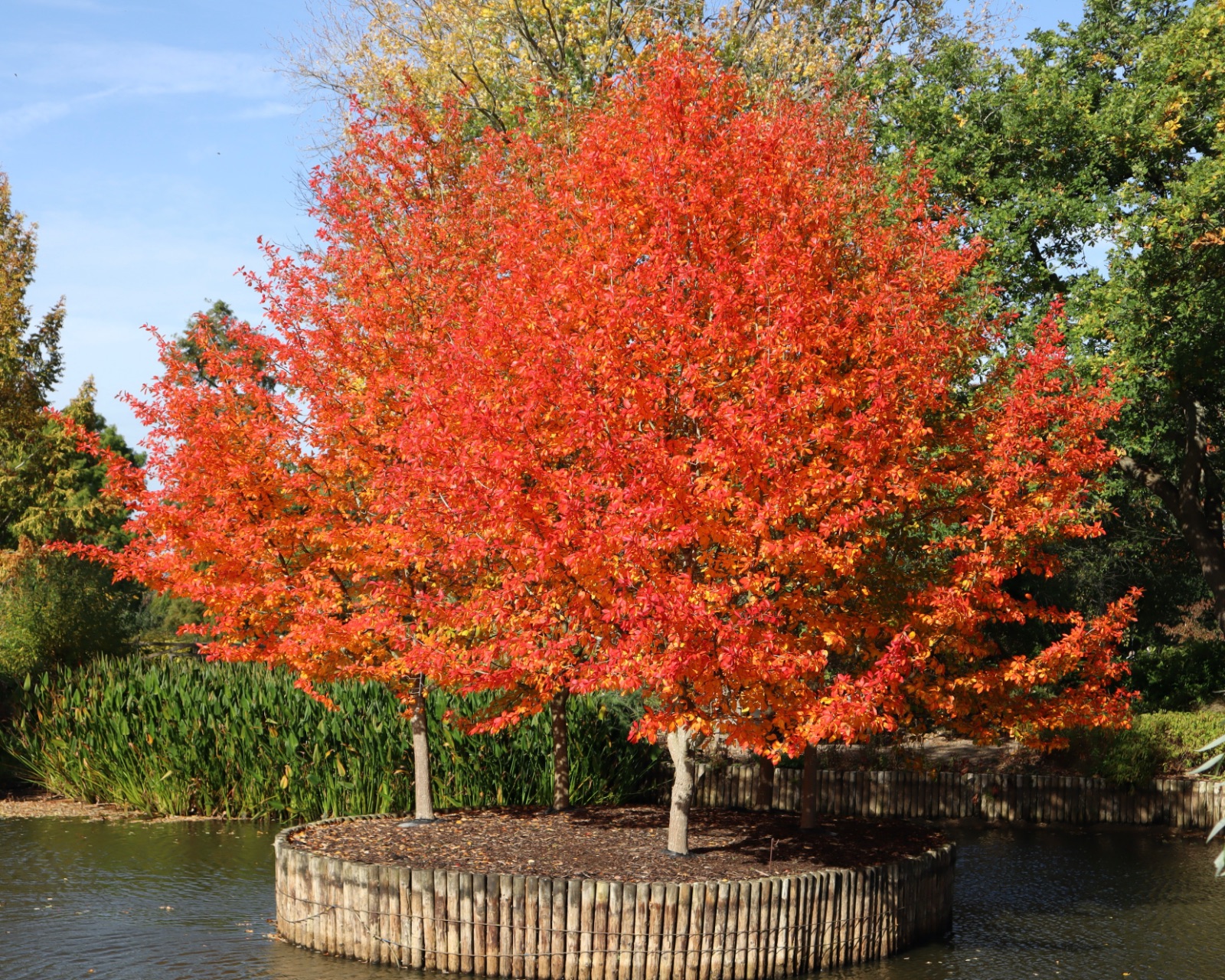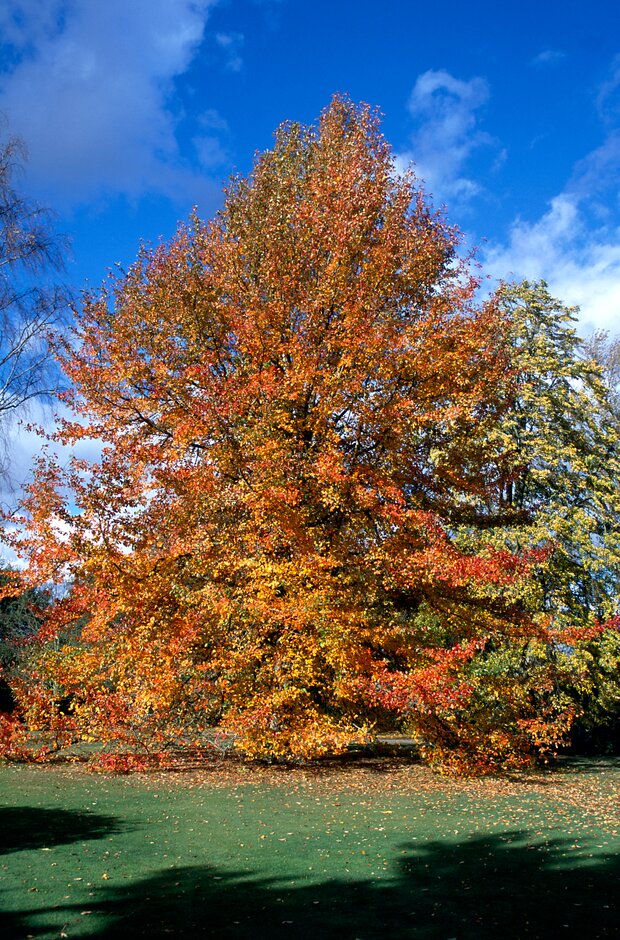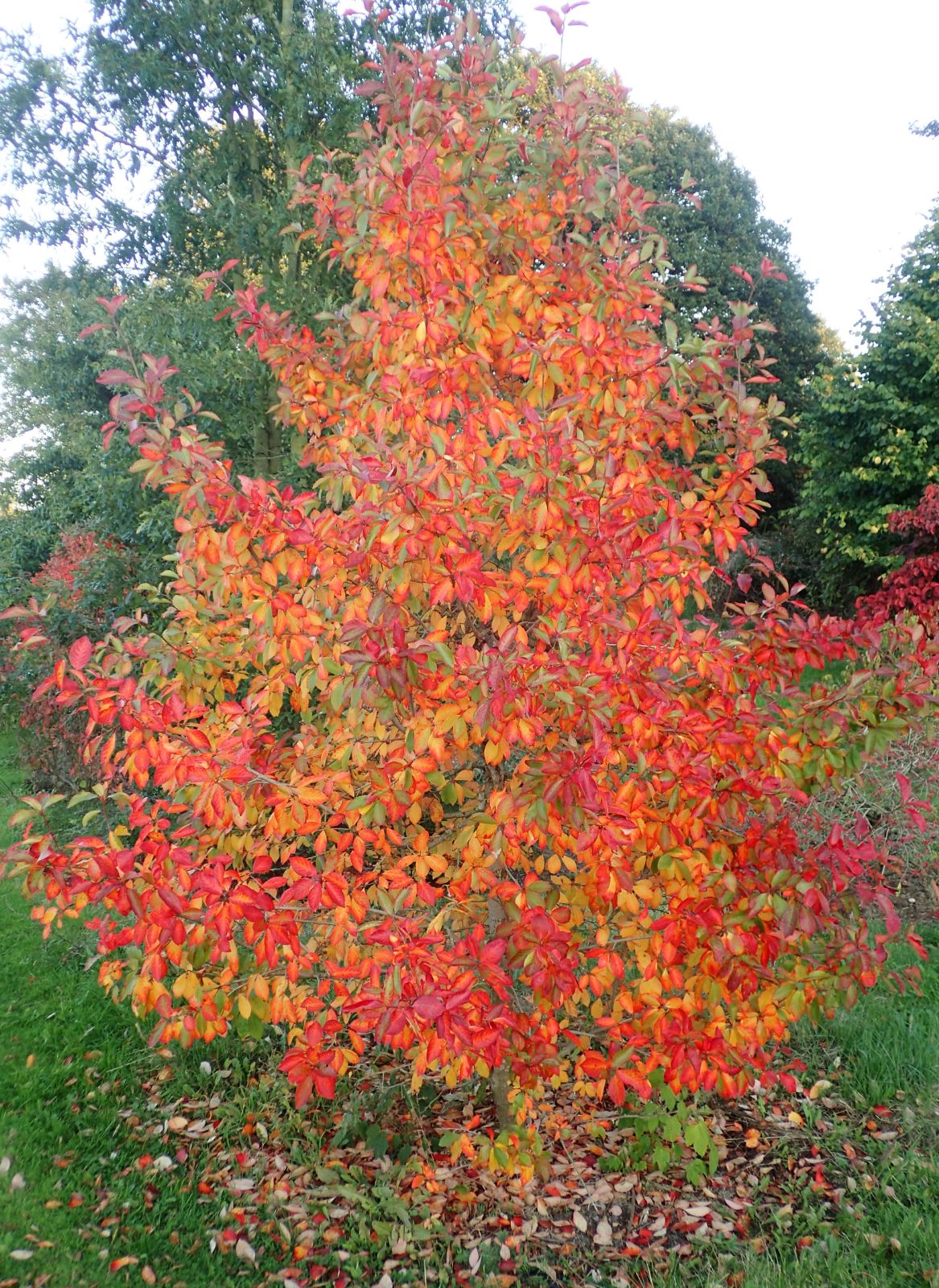Nyssa sylvatica
Sponsor
Kindly sponsored by a member of the International Dendrology Society.
Credits
Owen Johnson (2021)
Recommended citation
Johnson, O. (2021), 'Nyssa sylvatica' from the website Trees and Shrubs Online (treesandshrubsonline.
Genus
Common Names
- Tupelo
- Beetlebung
- Black Gum
- Pepperidge
- Snag Tree
- Sour Gum
- Swamp Hornbeam
Synonyms
- Nyssa multiflora Wangenh.
- Nyssa villosa Michx.
- Nyssa sylvatica var. caroliniana Fernald
- Nyssa sylvatica var. dilatata Fernald
Infraspecifics
- 'Ashmount Gold'
- 'Autumn Cascades'
- 'Carolyn'
- 'Cherry Pie'
- 'David Odom'
- 'Dirr'
- 'Forum'
- 'Gerhard Mann'
- 'Grechrist'
- 'Hayman's Red'
- 'High Beeches'
- 'Highlight'
- 'Isabel Grace'
- 'Jermyns Flame'
- 'JFS-PN Legacy1'
- 'JFS-Red'
- 'Lakeside Weeper'
- 'Miss Scarlet'
- 'Nsuhh'
- 'Pendula'
- 'Penwood Weeper'
- 'Red Fury'
- 'Red Jeanne'
- 'Red Red Wine'
- 'Red Vain'
- 'Sheffield Park'
- 'Sheri's Cloud'
- 'The James'
- 'Valley Scorcher'
- 'WFH1'
- 'Wildfire'
- 'Wisley Bonfire'
- 'Yiping'
- 'Zydeco Twist'
Other taxa in genus
Tree to 30 m, crown irregular, lower branches often drooping. Bark grey brown, soon ruggedly and deeply but rather regularly fissured. Twigs grey brown, puberulent, with sharp reddish buds, the terminal bud conic to approx. 1 cm long. Leaves obovate to elliptic, 6–12(–16) × 3–6(–9) cm, base cuneate to rounded, tip acute to acuminate, entire or with a few big teeth towards the tip; glabrous and matt or shiny above, matt and sometimes puberulent beneath; petiole 5–15(–30) mm, soon glabrous. Inflorescences on peduncles 36–43 mm long, sparsely hairy or glabrous. Male flowers in groups of 2–5(–7), rarely single; female and bisexual flowers in groups of (2–)3–5(–8). Staminate pedicels present. Ovary glabrous. Fruit borne singly, or in 2s or 3s, blue black, glaucous, ovoid to ellipsoid, 8–12 mm long; stone 7–9 mm, with low and rounded longitudinal ridges. (Flora of North America 2021; Bean 1976).
Distribution Canada In the far south of Ontario Mexico Scattered in mountains in the south and centre of the country United States Alabama, Arkansas, Connecticut, Delaware, Florida, Georgia, Illinois, Indiana, Kentucky, Louisiana, Maine, Maryland, Massachusetts, Michigan, Mississippi, Missouri, New Hampshire, New Jersey, New York, North Carolina, Ohio, Oklahoma, Pennsylvania, Rhode Island, South Carolina, Tennessee, Texas, Vermont, Virginia, West Virginia, Wisconsin
Habitat Swamps, wet savannas, moist woodlands; sometimes in drier sites, 0–1,100(–1,600) m asl.
USDA Hardiness Zone 4
RHS Hardiness Rating H6
Awards AGM
Conservation status Least concern (LC)
Nyssa sylvatica is the most widespread and adaptable of the four Nyssa species in the eastern and southern United States, where it is commonly cultivated. N. sylvatica is set apart by its trunk, which lacks the flared base – an adaptation to periodic flooding – found in the other large-growing species, and the deep ridges in the mature bark are aligned more regularly; the leaves are relatively large and often broad but short-stalked. It is the longest-lived broadleaf in the east of the United States, with an age of 679 years determined in 2000 for one in New Hampshire, at the northern extremity of its natural range (Columbia University 2013).
Although not an economically important tree, the Tupelo is common enough in American woodlands to have been introduced to Europe at quite an early date, and the Duke of Argyll had one in his collection at Whitton (now in west London) by 1750 (Johnson 2015). The species’s ornamental value in the United Kingdom was perhaps first fully recognised by Arthur Soames who, in the years from 1909 to 1924, transformed ‘Capability’ Brown’s parkland at Sheffield Park in East Sussex into a fashionable ‘wild garden’, particularly rich in autumn-colouring plants. He planted about 400 Tupelos, which had been raised from seed probably by Vilmorin’s nursery in France (Andrews 2001). A hundred years later, nearly 70 of these survive (Tree Register 2021): No other species of tree in the United Kingdom or Ireland has such a concentration of its best specimens at a single site. That c. 75% have died in the first 100 years after planting may seem a high mortality rate, but Tupelo is potentially a long-lived tree in cultivation here and nearly always looks healthy and happy, though it does seem vulnerable to storm damage and to the fungal infections that this can admit.
The large assemblage of seed-grown examples extant at Sheffield Park reveals what a variable species N. sylvatica is: some are low-domed; some have long, clean boles; others weep, with masses of drooping branches. In autumn, they can turn clear yellow, dull orange or fiery scarlet. The leaves can be glossy or matt and as broad as beech leaves or as narrow as those of Magnolia salicifolia. This inherent variability, coupled with the genus’s lack of obviously distinctive features, makes Tupelo a tricky tree to recognise; many tree watchers – in any month other than October – must have run through a mental list of possible identities before the process of rejecting all of them finally makes them realise that it has to be a Nyssa. Two species in particular that share the Tupelo’s natural habitat, rounded stature, brilliant autumn colours and rugged bark are Sassafras albidum, some of whose leaves are deeply lobed, and Oxydendrum arboreum, whose leaves on close inspection are finely serrated; neither of these lookalikes are at all closely related, and both have very different flowers and seeds.
Although it is perhaps an anonymous tree, Tupelo is not a dull one. In winter, the massively ridged bark is a delight, and, all through summer, the foliage, held in dense and graceful masses, is generally a bright moss green. For a plant that only excels for a couple of weeks, a mature specimen does admittedly take up a lot of room, especially when its lower branches are allowed to sweep the ground, and two particular demerits are some specimens’ tendency to sucker aggressively, and saplings’ delicate taproot, which makes transplanting tricky. This said, one purchased from Barcham Trees at large-standard size, at the author’s suggestion, has established very well in heavy clay in my local public park, Alexandra Park in Hastings, and the species’s ability to tolerate poor and waterlogged sites probably equips it to cope well with compacted urban soils.
Tupelo’s longevity in cultivation is suggested by the example at Munden in Hertfordshire, which was planted in or around 1832 by an earlier generation of the Holland-Hibbert family and, by 2018, was only 8 m tall but had a spread of 20 m. Thanks to old breakages or even clipping, its branches are remarkably crooked and rest on a partly collapsed cast-iron trellis (Tree Register 2021). Mr Holland-Hibbert describes its autumn colour as disappointing.
Tupelo is not a common tree in the United Kingdom and Ireland, but there are healthy, mature examples at sites including Holkham Hall near the north Norfolk coast, the Old Parsonage Gardens in Manchester, Picton Castle in Pembrokeshire, Bulkeley Mill in Snowdonia, Mount Usher in County Wicklow, Dunloe Castle in County Kerry, Galloway House in the southwest corner of Scotland and Crathes Castle in Aberdeenshire. Astute readers will realise that this list was chosen to include just about every major subdivision of these islands’ remarkably variable climate. Good trees in Silk Wood at Westonbirt, Gloucestershire, and at Dyffryn, Glamorgan, also indicate the species’s ability to thrive in moderately alkaline conditions, though autumn colour is likelier to be muted here.
In the warmer summers of the near continent, Tupelos grow slightly more freely, reaching 25 m at Arboretum Tervuren in Belgium and 24 m × 102 cm dbh at the Arboretum de Balaine in central France (monumentaltrees.com 2021); they are hardy at the Gothenburg Botanical Garden in southwest Sweden (Andrews 2001). They are also grown in Australia and colour well, against an evergreen backdrop of Eucalyptus, at the Auckland Botanic Gardens in New Zealand.
Being such a variable tree, numerous selections of Nyssa sylvatica have been made in recent decades, for autumn colour and, particularly in North America where it is now employed as a street tree, for a straighter and less spreading habit, and sometimes for resistance to leaf spot. An almost completely different range of clones is marketed in northwestern Europe, where trees will respond differently to the lower light levels and cooler summers. Clones that are too obscure to merit their own entry on this site include:
‘Dirr’ (‘Dirr Selection’), chosen at the J.C. Raulston Arboretum in North Carolina by Dr Raulston for its large, glossy leaves (Hatch 2018–2020) and named to honour the horticultural writer Michael Dirr (who himself describes the habit as ‘stiff and coarse’ (Dirr 2009)). It is represented in England at the National Collection of Nyssa at Exbury in Hampshire.
‘Highlight’, of unknown origin, is also grown in the Exbury collection.
‘Red Fury’ was selected at the Bernheim Arboretum in Kentucky for its bright red autumn colour (Hatch 2018–2020).
‘Red Jeanne’ was selected by John Trexler at the Tower Hill Botanic Garden in Massachusetts, but Michael Dirr, further south in Georgia, considers its autumn colour poor (Dirr 2009).
‘Red Vain’ is described by Plant Lust as weeping; it may be the same as ‘Red Vein’, described by the Davidsan’s Japanese Maples nursery as upright in habit.
'Ashmount Gold'
This selection, with pale yellow autumn colour, was first distributed in Holland in 2017 (Hatch 2021–2022). It is now also sold in France and by Shanahan’s Garden Centre in Ireland, whose description implies, uniquely, that it is also golden-leaved through the growing season (and as such needs partial shade).
'Autumn Cascades'
Synonyms / alternative names
'Autumn Cascade'
An Australian selection with a low, weeping habit and broad short leaves turning orange to red in autumn. It is now also available in New Zealand, western Europe and the United States.
'Carolyn'
Synonyms / alternative names
A female clone selected for its hardiness in New Hampshire by Dr Ed Hasselkus (Dirr 2009) and grown at the University of Wisconsin Arboretum at Madison. ‘Carolyn’ has been sold in the United States by Song Sparrow Farm and Nursery since 2003 (Hatch 2021–2022).
'Cherry Pie'
Synonyms / alternative names
Nyssa sylvatica WHITE CHAPEL™
A selection made in 2006 by John Barbour of Bold Spring Nursery in Hawkinsville, Georgia, and sold by several American nurseries since 2017 (Hatch 2018–2020). It forms a good straight stem and is bright red in autumn.
'David Odom'
Synonyms / alternative names
Nyssa sylvatica AFTERBURNER®
Selected by J Frank Schmidt nurseries, Oregon, and named to commemorate the arborist David Odom. It forms a good straight stem, and its particularly glossy leaves turn red rather late in autumn (Hatch 2018–2020). It does not yet seem to be available in Europe.
'Dirr'
Synonyms / alternative names
Nyssa sylvatica 'Dirr Selection'
Selected at the J.C. Raulston Arboretum in North Carolina by Dr Raulston for its large, glossy leaves (Hatch 2018–2020) and named to honour the horticultural writer Michael Dirr (who himself describes the habit as ‘stiff and coarse’ (Dirr 2009)). It is represented in England at the National Collection of Nyssa at Exbury in Hampshire.
'Forum'
Synonyms / alternative names
Selected from a seedling at Athens, Georgia, for its rapid growth, dense, conic form in youth, particularly shiny leaves and red autumn colour, with gold bleeding along the veins (Hatch 2021–2022). It is now sold mainly in Australia, where it is recommended by Flemings Nursery as a street tree.
'Gerhard Mann'
Selected at Arboretum Ellerhoop in Germany in 1998 and named after the arboretum’s head gardener. Autumn colour is scarlet (Andrews 2001).
'Grechrist'
Synonyms / alternative names
Nyssa sylvatica SNOW FLURRIES™
A showy, variegated sport with an irregular creamy white margin to each leaf, selected by the Greenleaf Nursery in Oklahama in 2011 (Hatch 2021–2022). It represents perhaps the same mutation as ‘Sheri’s Cloud’ (q.v.) but is currently the more popular form in the United States. The variant spelling ‘Gechrist’ appears in Larry Hatch’s database of cultivars (Hatch 2021–2022).
'Hayman's Red'
Synonyms / alternative names
Nyssa sylvatica RED RAGE™
Nyssa sylvatica 'Haymanred'
‘Hayman’s Red’ was selected by Mike Hayman in Kentucky or Indiana and is now sold both in the United States and the United Kingdom. Michael Dirr (Dirr 2009) considers it the best available clone, at least in the climate of the southeastern states, for its dark glossy foliage, uniform red autumn colour and neat, straight-stemmed habit. It is grown in the United Kingdom’s National Collection at Exbury (Exbury Garden 2021).
'High Beeches'
One of several big Tupelos at High Beeches Gardens in West Sussex (‘323’) was awarded a first-class certificate by the Royal Horticultural Society in 1968 for its autumn colour which – in that garden’s acidic soil – is a rich mixture of crimson, pink and gold (Hillier & Coombes 2002); it is also a shapely tree, 15 m tall in 1997 (Tree Register 2021). It is hard to propagate by grafting, but easy to raise from its abundant suckers (Andrews 2001), which are its only demerit as a garden form.
'Highlight'
Of unknown origin, a plant bearing this name is also grown in the Exbury collection, UK (pers. obs.).
'Isabel Grace'
A female plant, ‘Isabel Grace’ has slender leaves and grows slowly, with densely drooping branches; a tree at Sheffield Park, East Sussex, is only 3 m tall (Tree Register 2021) and resembles a large heap of leaves, like some weeping clones of beech (Fagus sylvatica). In autumn, these leaves turn orange, but Michael Dirr was unimpressed by this colour in his trials of Nyssa clones in the very different climate of Georgia in the United States (Dirr 2009). The cultivar is sold in the United Kingdom, occasionally under the variant spelling ‘Isobel Grace’.
'Jermyns Flame'
‘Jermyns Flame’ was selected by John Hillier in 1985 from a tree growing in the Sir Harold Hillier Gardens, Hampshire; its large leaves turn red, orange and yellow in autumn (Exbury Garden 2021). The current example in the gardens was 8.6 m tall in 2001 (Tree Register 2021). The clone is sold in the United Kingdom and by Esveld in the Netherlands.
'JFS-PN Legacy1'
Synonyms / alternative names
Nyssa sylvatica GUMDROP®
Selected by J. Frank Schmidt nursery in Oregon for its dense and compact habit; now sold in the United States.
'JFS-Red'
Synonyms / alternative names
Nyssa sylvatica FIRESTARTER®
A selection from J. Frank Schmidt in Oregon, with a neater, more regular habit than most Tupelos. A strong leader ensures a clean bole, and trees bear upsweeping branches that carry dark foliage, which turns crimson early in autumn; young plants, at least, do not fruit (Hatch 2021–2022). It is now widely sold in the United States.
'Lakeside Weeper'
This form, with unusually drooping lower branches, was found near Lake Jordan in North Carolina by Eddie Bennett and sold from 2004 by the Camellia Forest Nursery (Hatch 2021–2022). It is now available both in the United States and the United Kingdom, but Michael Dirr (Dirr 2009) considers it a poor tree in Georgia, where it is particularly vulnerable to leaf spot.
'Miss Scarlet'
A form selected by the Arborvillage Farm Nursery in Missouri in 1993 (Hatch 2018–2020). This is a free-fruiting female tree, with a compact habit and dark glossy leaves, turning red in autumn, though Michael Dirr (Dirr 2009) finds its colour relatively disappointing in Georgia. ‘Miss Scarlet’ has been sold in the United Kingdom since 2006.
'Nsuhh'
Synonyms / alternative names
Nyssa sylvatica GREEN GABLE™
A selection made in 2002 by Alex Neubauer of the Hidden Hollow Nursery in Tennessee, from a tree at Rock Island in that state. It is a mostly male (non-fruiting) clone of good vigour, with a very regular conic habit and good red autumn colour. Its glossier-than-average leaves show increased resistance to leaf spot (Hatch 2021–2022). It is now sold around the United States.
'Pendula'
Tupelos often develop drooping lower branches, and the clone ‘Pendula’ is represented at the Dawes Arboretum in Ohio and the Arnold Arboretum in Massachusetts (Hatch 2018–2020), though there seems not to be any evidence that it is an old-enough selection for the latinate name to be valid. In the United Kingdom’s National Collection at Exbury, it scarcely weeps at all (Exbury Garden 2021), though one purchased from RHS Wisley’s garden centre in 1988 by Nicholas Smith, and growing at Wynkcoombe Arboretum in West Sussex, has developed an attractively drooping habit. In America, it has been sold by Forest Farm Nursery in Oregon (Hatch 2018–2020), but the clone may no longer be available commercially.
'Penwood Weeper'
The original tree, dating from the mid-20th century, grows in Lakeside Park in Kentucky, and has a straight bole and gracefully drooping branches across a relatively broad canopy; it is a female plant, with yellow and orange autumn tints. It has been propagated by Steve Foltz at the Cincinnati Zoo and Botanical Gardens (Hatch 2021–2022) and is sold by Rutgers in the United States.
'Red Fury'
‘Red Fury’ was selected at the Bernheim Arboretum in Kentucky for its bright red autumn colour (Hatch 2018–2020).
'Red Jeanne'
‘Red Jeanne’ was selected by John Trexler at the Tower Hill Botanic Garden in Massachusetts, but Michael Dirr, further south in Georgia, considers its autumn colour poor (Dirr 2009).
'Red Red Wine'
A selection sold in Europe by 1987 (Andrews 2001) and represented in the United Kingdom National Collection at Exbury (Exbury Garden 2021); it is also available in Australia. Young leaves are reddish and turn dark red again in autumn. The variant name ‘Red Wine’ is occasional.
'Red Vain'
‘Red Vain’ is described by Plant Lust as weeping; it may be the same as ‘Red Vein’, described by the Davidsan’s Japanese Maples nursery as upright in habit.
'Sheffield Park'
The original tree, northeast of the Second Lake at Sheffield Park in East Sussex, is one of some 70 survivors here from Arthur Soames’s plantings in the first decades of the 20th century. By 2012 it was 15 m × 65 cm dbh (Tree Register 2021) and stands out for its gracefully domed crown and its orange red autumn colours, which start 2 or 3 weeks earlier than most and have the double advantage of lasting longer (Andrews 2001). It has been sold for many years by the Hillier nurseries; the scion in the Sir Harold Hillier Gardens was 10 m tall by 2008 (Tree Register 2008).
'Sheri's Cloud'
A Tupelo sport with a broad grey white marginal variegation was spotted in a roadside ditch in Arkansas by Jeff Flanagan in 2002 and named after his wife (Dirr 2009); it was commercially available from around 2005 (Hatch 2018–2020) but had yet to reach Europe in 2021. Michael Dirr (Dirr 2009) goes so far as to compare the effect in summer to that of the Wedding Cake Tree, Cornus controversa ‘Variegata’, though the dense layers of foliage are never so neatly tabular; in autumn, the white bits of the leaf turn pink, and the centre turns a deeper red.
SNOW FLURRIES™ (‘Grechrist’) has been sold by the Greenleaf Nursery in Oklahama since 2011 (Hatch 2018–2020) and is now widely available in the United States; it appears almost identical in photos, though the marginal variegation is described as less regular.
'The James'
Synonyms / alternative names
Nyssa sylvatica FOREST FIRE™
A form selected by James A. Hines in McMinnville, Tennessee, and sold in the United States by 2013. It is described as a vigorous tree with a dense, ovoid crown and large glossy leaves (to 10.4 × 4.4 cm) whose stalks and tips often stay red, and whose autumn colours are red and orange (Hatch 2021–2022).
'Valley Scorcher'
Synonyms / alternative names
Nyssa sylvatica 'Windsor'
Selected by John Bond, the late keeper of the Valley Gardens, Windsor Great Park, Berkshire, for its rich orange autumn colour (Hatch 2021–2022) and now sold by several nurseries in the United Kingdom.
'WFH1'
Synonyms / alternative names
Nyssa sylvatica TUPELO TOWER™
A straight, narrow selection from Klyn Nurseries, Ohio – the nearest thing so far to a fastigiate Tupelo – hardy to USDA Zone 4 (Hatch 2018–2020), with yellow to orange autumn colour (Specimen Trees Nursery). It is now sold by several suppliers in the United States.
'Wildfire'
A selection made by Steve Hottovy at the Beyond Green nurseries in Oregon for the clear red of its young growth and now available both in the United States and the United Kingdom. Autumn colour (Dirr 2009) can be disappointing. In the UK’s National Collection at Exbury, it is represented under the variant name ‘Wild Fire’ (Exbury Garden 2021).
'Wisley Bonfire'
Awards
AGM
The original tree, on the Seven Acres lawn at the Royal Horticultural Society’s Garden, Wisley, Surrey, was admired by many for its neat, almost conic shape and its dark shiny leaves, which turned red and orange in autumn; it was 16 m × 51 cm dbh by 2010 (Tree Register 2021). Scions were commercially available from 1998 (Hatch 2018–2020), and this soon become one of the most popular Tupelo clones in the United Kingdom and the Netherlands.
Its name proved sadly prophetic for the original tree, which, despite its robust-looking, good form, split in half and collapsed; because, for environmental reasons, the staff at Wisley no longer use bonfires, it was chipped and used as mulch instead.
'Yiping'
Common Names
Variegated Tupelo
Synonyms / alternative names
Nyssa sylvatica JOLLY™
A variegated Tupelo is now sold under this name (by Willoway Nurseries) in the United States; its leaves are dappled with milky-white and the variegation is brighter on later growths from midsummer, though some online photos seem to show the consistent marginal variegation that is a feature of ‘Sheri’s Cloud’ (q.v.). In the United Kingdom, N. sylvatica JOLLY™ is sold by Packhorse Farm Nursery in Derbyshire.
What appears to be an identical mutation has long been grown at Holkham Hall in north Norfolk, where the smallest of three mature Tupelos in the Pleasure Grounds, 11 m × 37 cm dbh in 2014 (Tree Register 2021), shows a similar white pattern on late growths; the variegation is sometimes concentrated towards the margin but is never really showy, though the autumn colour in this sandy soil is a good red (Andrews 2001). Two scions from this tree were established here in the 1990s by the head gardener, Paul Miles (Andrews 2001). At Bodnant in north Wales, a 15 m tree shows the same variegation, as do younger trees at Penberth in Cornwall and Thenford House in Northamptonshire – a good enough geographical spread to disassociate the variegation from any particular soil or microclimate.
An apparently distinct sport with a greeny yellow mottling, concentrated around the leaf margin in younger plants, has been raised in Texas by Ray Jackson (Dirr 2009), but apparently not named.
'Zydeco Twist'
This remarkable sport, with contorted twigs and young branches but a conic form and a straight bole, was named by Dr Todd Lasseigne of the Tulsa Botanical Garden, Oklahoma, and is said to have been found in Louisiana (Dirr 2009); it was sold from 2003 by Rick’s Custom Nursery in Virginia (Hatch 2018–2020). In the United States, it is susceptible to leaf spot, and its autumn colours are average for the species (Dirr 2009); nevertheless, it is now available. As of 2021, the cultivar seemed not to have reached Europe.




